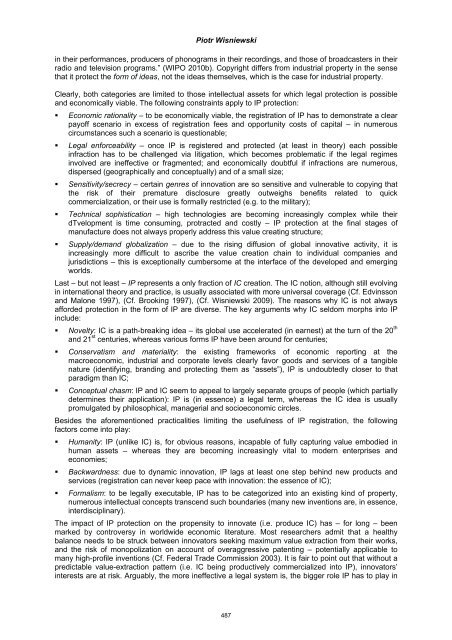Proceedings of the 3rd European Conference on Intellectual Capital
Proceedings of the 3rd European Conference on Intellectual Capital
Proceedings of the 3rd European Conference on Intellectual Capital
Create successful ePaper yourself
Turn your PDF publications into a flip-book with our unique Google optimized e-Paper software.
Piotr Wisniewski<br />
in <str<strong>on</strong>g>the</str<strong>on</strong>g>ir performances, producers <str<strong>on</strong>g>of</str<strong>on</strong>g> ph<strong>on</strong>ograms in <str<strong>on</strong>g>the</str<strong>on</strong>g>ir recordings, and those <str<strong>on</strong>g>of</str<strong>on</strong>g> broadcasters in <str<strong>on</strong>g>the</str<strong>on</strong>g>ir<br />
radio and televisi<strong>on</strong> programs.” (WIPO 2010b). Copyright differs from industrial property in <str<strong>on</strong>g>the</str<strong>on</strong>g> sense<br />
that it protect <str<strong>on</strong>g>the</str<strong>on</strong>g> form <str<strong>on</strong>g>of</str<strong>on</strong>g> ideas, not <str<strong>on</strong>g>the</str<strong>on</strong>g> ideas <str<strong>on</strong>g>the</str<strong>on</strong>g>mselves, which is <str<strong>on</strong>g>the</str<strong>on</strong>g> case for industrial property.<br />
Clearly, both categories are limited to those intellectual assets for which legal protecti<strong>on</strong> is possible<br />
and ec<strong>on</strong>omically viable. The following c<strong>on</strong>straints apply to IP protecti<strong>on</strong>:<br />
Ec<strong>on</strong>omic rati<strong>on</strong>ality – to be ec<strong>on</strong>omically viable, <str<strong>on</strong>g>the</str<strong>on</strong>g> registrati<strong>on</strong> <str<strong>on</strong>g>of</str<strong>on</strong>g> IP has to dem<strong>on</strong>strate a clear<br />
pay<str<strong>on</strong>g>of</str<strong>on</strong>g>f scenario in excess <str<strong>on</strong>g>of</str<strong>on</strong>g> registrati<strong>on</strong> fees and opportunity costs <str<strong>on</strong>g>of</str<strong>on</strong>g> capital – in numerous<br />
circumstances such a scenario is questi<strong>on</strong>able;<br />
Legal enforceability – <strong>on</strong>ce IP is registered and protected (at least in <str<strong>on</strong>g>the</str<strong>on</strong>g>ory) each possible<br />
infracti<strong>on</strong> has to be challenged via litigati<strong>on</strong>, which becomes problematic if <str<strong>on</strong>g>the</str<strong>on</strong>g> legal regimes<br />
involved are ineffective or fragmented; and ec<strong>on</strong>omically doubtful if infracti<strong>on</strong>s are numerous,<br />
dispersed (geographically and c<strong>on</strong>ceptually) and <str<strong>on</strong>g>of</str<strong>on</strong>g> a small size;<br />
Sensitivity/secrecy – certain genres <str<strong>on</strong>g>of</str<strong>on</strong>g> innovati<strong>on</strong> are so sensitive and vulnerable to copying that<br />
<str<strong>on</strong>g>the</str<strong>on</strong>g> risk <str<strong>on</strong>g>of</str<strong>on</strong>g> <str<strong>on</strong>g>the</str<strong>on</strong>g>ir premature disclosure greatly outweighs benefits related to quick<br />
<br />
commercializati<strong>on</strong>, or <str<strong>on</strong>g>the</str<strong>on</strong>g>ir use is formally restricted (e.g. to <str<strong>on</strong>g>the</str<strong>on</strong>g> military);<br />
Technical sophisticati<strong>on</strong> – high technologies are becoming increasingly complex while <str<strong>on</strong>g>the</str<strong>on</strong>g>ir<br />
dTvelopment is time c<strong>on</strong>suming, protracted and costly – IP protecti<strong>on</strong> at <str<strong>on</strong>g>the</str<strong>on</strong>g> final stages <str<strong>on</strong>g>of</str<strong>on</strong>g><br />
manufacture does not always properly address this value creating structure;<br />
Supply/demand globalizati<strong>on</strong> – due to <str<strong>on</strong>g>the</str<strong>on</strong>g> rising diffusi<strong>on</strong> <str<strong>on</strong>g>of</str<strong>on</strong>g> global innovative activity, it is<br />
increasingly more difficult to ascribe <str<strong>on</strong>g>the</str<strong>on</strong>g> value creati<strong>on</strong> chain to individual companies and<br />
jurisdicti<strong>on</strong>s – this is excepti<strong>on</strong>ally cumbersome at <str<strong>on</strong>g>the</str<strong>on</strong>g> interface <str<strong>on</strong>g>of</str<strong>on</strong>g> <str<strong>on</strong>g>the</str<strong>on</strong>g> developed and emerging<br />
worlds.<br />
Last – but not least – IP represents a <strong>on</strong>ly fracti<strong>on</strong> <str<strong>on</strong>g>of</str<strong>on</strong>g> IC creati<strong>on</strong>. The IC noti<strong>on</strong>, although still evolving<br />
in internati<strong>on</strong>al <str<strong>on</strong>g>the</str<strong>on</strong>g>ory and practice, is usually associated with more universal coverage (Cf. Edvinss<strong>on</strong><br />
and Mal<strong>on</strong>e 1997), (Cf. Brooking 1997), (Cf. Wisniewski 2009). The reas<strong>on</strong>s why IC is not always<br />
afforded protecti<strong>on</strong> in <str<strong>on</strong>g>the</str<strong>on</strong>g> form <str<strong>on</strong>g>of</str<strong>on</strong>g> IP are diverse. The key arguments why IC seldom morphs into IP<br />
include:<br />
Novelty: IC is a path-breaking idea – its global use accelerated (in earnest) at <str<strong>on</strong>g>the</str<strong>on</strong>g> turn <str<strong>on</strong>g>of</str<strong>on</strong>g> <str<strong>on</strong>g>the</str<strong>on</strong>g> 20 th<br />
and 21 st centuries, whereas various forms IP have been around for centuries;<br />
C<strong>on</strong>servatism and materiality: <str<strong>on</strong>g>the</str<strong>on</strong>g> existing frameworks <str<strong>on</strong>g>of</str<strong>on</strong>g> ec<strong>on</strong>omic reporting at <str<strong>on</strong>g>the</str<strong>on</strong>g><br />
macroec<strong>on</strong>omic, industrial and corporate levels clearly favor goods and services <str<strong>on</strong>g>of</str<strong>on</strong>g> a tangible<br />
nature (identifying, branding and protecting <str<strong>on</strong>g>the</str<strong>on</strong>g>m as “assets”), IP is undoubtedly closer to that<br />
paradigm than IC;<br />
C<strong>on</strong>ceptual chasm: IP and IC seem to appeal to largely separate groups <str<strong>on</strong>g>of</str<strong>on</strong>g> people (which partially<br />
determines <str<strong>on</strong>g>the</str<strong>on</strong>g>ir applicati<strong>on</strong>): IP is (in essence) a legal term, whereas <str<strong>on</strong>g>the</str<strong>on</strong>g> IC idea is usually<br />
promulgated by philosophical, managerial and socioec<strong>on</strong>omic circles.<br />
Besides <str<strong>on</strong>g>the</str<strong>on</strong>g> aforementi<strong>on</strong>ed practicalities limiting <str<strong>on</strong>g>the</str<strong>on</strong>g> usefulness <str<strong>on</strong>g>of</str<strong>on</strong>g> IP registrati<strong>on</strong>, <str<strong>on</strong>g>the</str<strong>on</strong>g> following<br />
factors come into play:<br />
Humanity: IP (unlike IC) is, for obvious reas<strong>on</strong>s, incapable <str<strong>on</strong>g>of</str<strong>on</strong>g> fully capturing value embodied in<br />
human assets – whereas <str<strong>on</strong>g>the</str<strong>on</strong>g>y are becoming increasingly vital to modern enterprises and<br />
ec<strong>on</strong>omies;<br />
Backwardness: due to dynamic innovati<strong>on</strong>, IP lags at least <strong>on</strong>e step behind new products and<br />
services (registrati<strong>on</strong> can never keep pace with innovati<strong>on</strong>: <str<strong>on</strong>g>the</str<strong>on</strong>g> essence <str<strong>on</strong>g>of</str<strong>on</strong>g> IC);<br />
Formalism: to be legally executable, IP has to be categorized into an existing kind <str<strong>on</strong>g>of</str<strong>on</strong>g> property,<br />
numerous intellectual c<strong>on</strong>cepts transcend such boundaries (many new inventi<strong>on</strong>s are, in essence,<br />
interdisciplinary).<br />
The impact <str<strong>on</strong>g>of</str<strong>on</strong>g> IP protecti<strong>on</strong> <strong>on</strong> <str<strong>on</strong>g>the</str<strong>on</strong>g> propensity to innovate (i.e. produce IC) has – for l<strong>on</strong>g – been<br />
marked by c<strong>on</strong>troversy in worldwide ec<strong>on</strong>omic literature. Most researchers admit that a healthy<br />
balance needs to be struck between innovators seeking maximum value extracti<strong>on</strong> from <str<strong>on</strong>g>the</str<strong>on</strong>g>ir works,<br />
and <str<strong>on</strong>g>the</str<strong>on</strong>g> risk <str<strong>on</strong>g>of</str<strong>on</strong>g> m<strong>on</strong>opolizati<strong>on</strong> <strong>on</strong> account <str<strong>on</strong>g>of</str<strong>on</strong>g> overaggressive patenting – potentially applicable to<br />
many high-pr<str<strong>on</strong>g>of</str<strong>on</strong>g>ile inventi<strong>on</strong>s (Cf. Federal Trade Commissi<strong>on</strong> 2003). It is fair to point out that without a<br />
predictable value-extracti<strong>on</strong> pattern (i.e. IC being productively commercialized into IP), innovators’<br />
interests are at risk. Arguably, <str<strong>on</strong>g>the</str<strong>on</strong>g> more ineffective a legal system is, <str<strong>on</strong>g>the</str<strong>on</strong>g> bigger role IP has to play in<br />
487
















